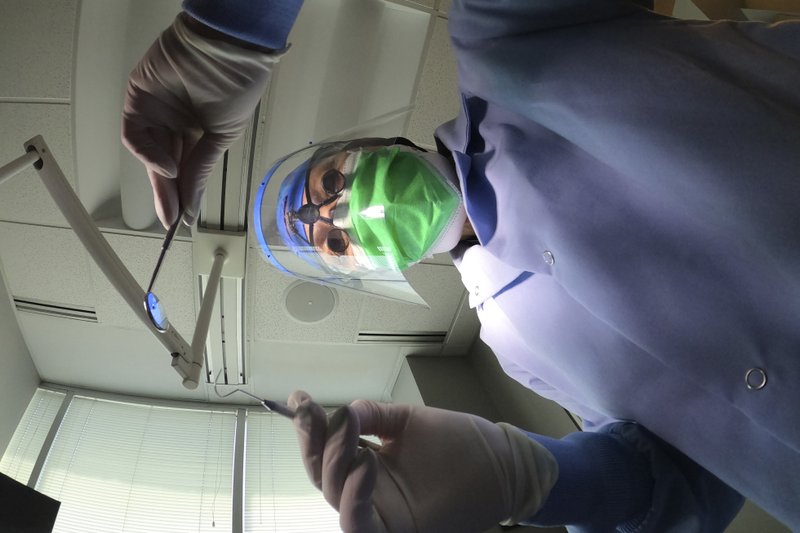U.S. dental offices are quickly bouncing back, but it won’t be business as usual. Expect social distancing, layers of protective gear and a new approach to some procedures to guard against coronavirus.
Dental offices largely closed, except for emergency care, after the Centers for Disease Control and Prevention recommended in March that they should delay elective procedures like teeth cleaning and filling cavities.
By April, only 3% of dental offices were open for non-emergency care, according to Marko Vujicic, chief economist with the American Dental Association’s Health Policy Institute.
Polling data shows about two-thirds were back open in May and Vujicic expects that to reach 97% by the end of June. He estimates that only 1% of dentists will ultimately sell their practices, retire or file for bankruptcy.
“They seem to have weathered the storm,” Vujicic said.
Dentists say government loans helped some of them survive the shutdown, and demand for their work is pushing them to reopen quickly.
“The need for even routine dental care never went away,” said Dr. Terri Tiersky, who runs a small practice in Skokie, Illinois. “We needed to get back to our patients … and our staff needed to get back to work, of course.”
Tiersky closed her office to all but emergencies in mid-March. She then helped arrange donations of personal protective equipment from the Chicago Dental Society for health workers treating COVID-19 patients.
She opened in early June after buying air purifiers and stocking back up on protective gear.
“We are bending over backwards to make sure our offices are ready and safe,” said Tiersky, who wears two masks when she sees patients.
Nickolette Karabush was one of Tiersky’s first patients to return after she cracked a tooth while eating popcorn. The 58-year-old Highwood, Illinois, resident has an autoimmune disorder and had been hunkered down at home since COVID-19 hit.
“The thought of having to go to a dentist office really just freaked me out,” she said.
Karabush settled down after she saw everyone in Tiersky’s office wearing masks and no one else in the waiting room.
“Everything was very clean,” she said. “It felt like a very safe environment.”
Tiersky and other dentists have taken several precautions like removing waiting room magazines and asking patients about COVID-19 symptoms before they receive care.
Dr. Kirk Norbo has an employee stationed in the foyer of his Purcellville, Virginia, dental office to take visitors’ temperatures before they enter the waiting room.
Then there’s the gear.
More of a “Star Wars look with the face shields and the mask and stuff and the gowns that a lot of offices had not used,” said Norbo, who remembers not even wearing gloves decades ago in dental school.
Some practices are charging an additional fee to cover the cost of that extra gear. Neither Norbo nor Tiersky say they are doing this.
Dentists also have changed how they practice. Coronavirus is spread from person to person mainly through droplets in the air when someone with an infection coughs, sneezes or talks. That’s why masks and social distancing are encouraged.
Dental work requires close quarters, and can generate a spray of saliva and water. Norbo and other dentists have returned to using hand tools for procedures like a teeth cleaning instead of instruments that may do the job faster, but create more of that spray.
Norbo said a paycheck protection loan of about $250,000 helped him bring back his staff and pay them until the business caught up after his office re-opened in early May.
Practices are climbing out of a big hole as they reopen. Personal spending on dental services dropped 61% in April compared to the same month last year, according to the nonprofit health research firm Altarum. That’s twice the decline experienced by the entire health care sector.
It might take a while for all business to return. Altarum economist Ani Turner noted that a lot of dental care is discretionary and can be postponed, and patients will still be worried about being exposed to the virus.
“People may tend to procrastinate on cleanings and maintenance anyway,” she said.
Norbo said those who have returned to his practice so far are glad to be back. He thinks the visits help people feel like they are “getting back into somewhat of a normal life.”
“It’s way more than just dentistry,” he said.
(AP)












2 Responses
Our dental practice has installed an inverted “umbrella” vacuum system over each dental chair to remove any droplets expelled during treatment along with individual room HEPA filters for additional air treatment. None of these expensive options are foolproof but they do reduce risk and make patients feel more secure. They are fortunate they could afford the hundreds of thousands of dollars for the new equipment which is not really an option for younger dentists starting practices or small solo practices
I need a good dentist and possible oral surgeon who take Medicaid in NYC prior to getting full dentures. Anyone have suggestions?